Exploring the Impact of Rewards on Employee Motivation in OB Essay
VerifiedAdded on 2023/06/08
|8
|2020
|149
Essay
AI Summary
This essay examines the role of rewards in motivating employees within the framework of organizational behavior. It discusses how employee behavior is crucial in the workplace and how rewarding performance is a planned action by managers to extract effective labor. The essay considers both monetary and non-monetary rewards, emphasizing that while monetary rewards can drive performance, they do not necessarily strengthen the relationship between managers and employees. Understanding and caring approaches from managers, along with safety and security, are highlighted as essential needs that contribute to employee motivation. The essay also explores the importance of training, a liberal managerial approach, and the direct link between employee motivation and performance, concluding that rewards serve as a medium connecting motivation and performance, ultimately enhancing organizational reputation and standards.

Running head: ORGANIZATIONAL BEHAVIOR
Role of rewards in motivating employees
Name of the student:
Name of the university:
Author note:
Role of rewards in motivating employees
Name of the student:
Name of the university:
Author note:
Paraphrase This Document
Need a fresh take? Get an instant paraphrase of this document with our AI Paraphraser
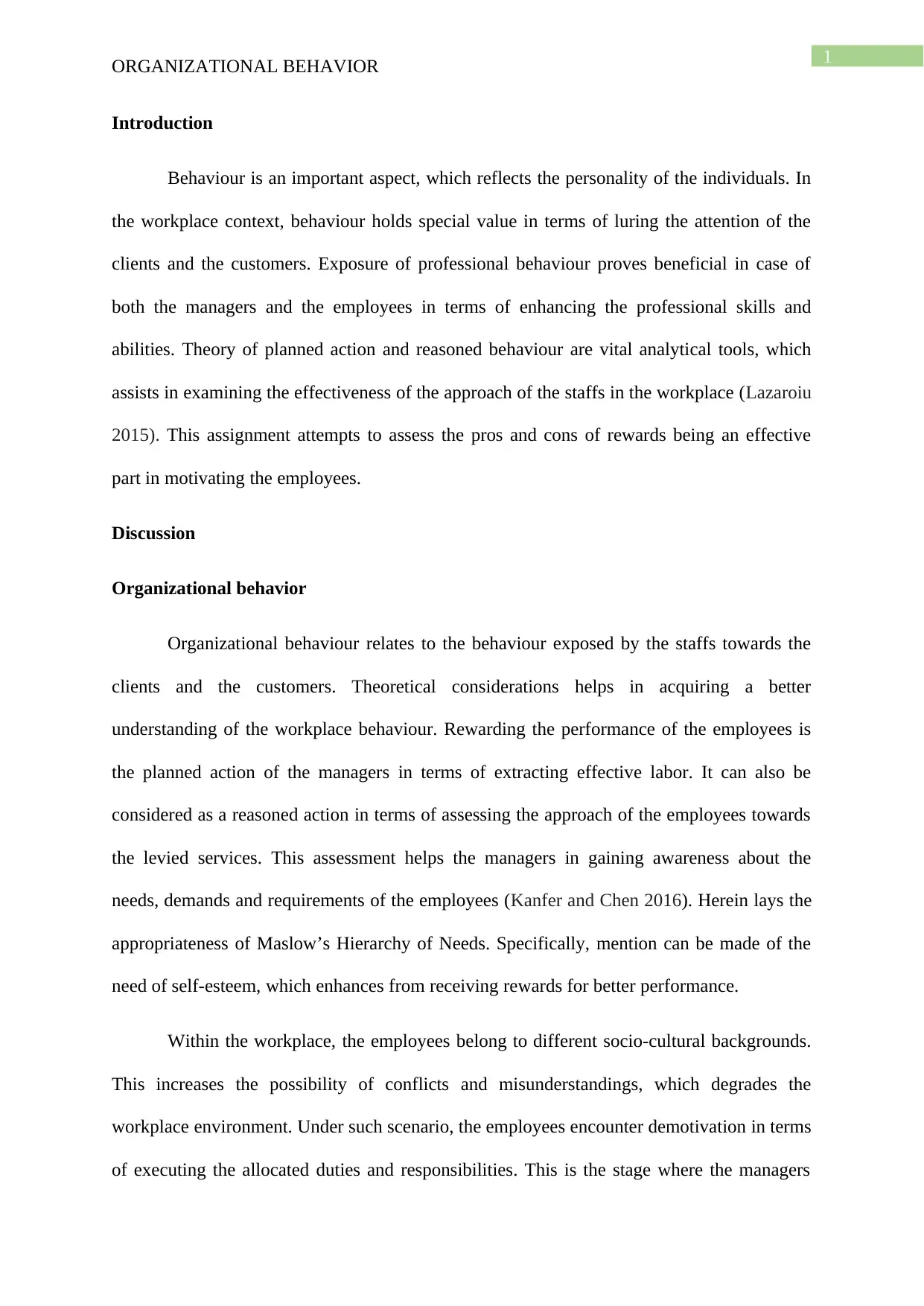
1
ORGANIZATIONAL BEHAVIOR
Introduction
Behaviour is an important aspect, which reflects the personality of the individuals. In
the workplace context, behaviour holds special value in terms of luring the attention of the
clients and the customers. Exposure of professional behaviour proves beneficial in case of
both the managers and the employees in terms of enhancing the professional skills and
abilities. Theory of planned action and reasoned behaviour are vital analytical tools, which
assists in examining the effectiveness of the approach of the staffs in the workplace (Lazaroiu
2015). This assignment attempts to assess the pros and cons of rewards being an effective
part in motivating the employees.
Discussion
Organizational behavior
Organizational behaviour relates to the behaviour exposed by the staffs towards the
clients and the customers. Theoretical considerations helps in acquiring a better
understanding of the workplace behaviour. Rewarding the performance of the employees is
the planned action of the managers in terms of extracting effective labor. It can also be
considered as a reasoned action in terms of assessing the approach of the employees towards
the levied services. This assessment helps the managers in gaining awareness about the
needs, demands and requirements of the employees (Kanfer and Chen 2016). Herein lays the
appropriateness of Maslow’s Hierarchy of Needs. Specifically, mention can be made of the
need of self-esteem, which enhances from receiving rewards for better performance.
Within the workplace, the employees belong to different socio-cultural backgrounds.
This increases the possibility of conflicts and misunderstandings, which degrades the
workplace environment. Under such scenario, the employees encounter demotivation in terms
of executing the allocated duties and responsibilities. This is the stage where the managers
ORGANIZATIONAL BEHAVIOR
Introduction
Behaviour is an important aspect, which reflects the personality of the individuals. In
the workplace context, behaviour holds special value in terms of luring the attention of the
clients and the customers. Exposure of professional behaviour proves beneficial in case of
both the managers and the employees in terms of enhancing the professional skills and
abilities. Theory of planned action and reasoned behaviour are vital analytical tools, which
assists in examining the effectiveness of the approach of the staffs in the workplace (Lazaroiu
2015). This assignment attempts to assess the pros and cons of rewards being an effective
part in motivating the employees.
Discussion
Organizational behavior
Organizational behaviour relates to the behaviour exposed by the staffs towards the
clients and the customers. Theoretical considerations helps in acquiring a better
understanding of the workplace behaviour. Rewarding the performance of the employees is
the planned action of the managers in terms of extracting effective labor. It can also be
considered as a reasoned action in terms of assessing the approach of the employees towards
the levied services. This assessment helps the managers in gaining awareness about the
needs, demands and requirements of the employees (Kanfer and Chen 2016). Herein lays the
appropriateness of Maslow’s Hierarchy of Needs. Specifically, mention can be made of the
need of self-esteem, which enhances from receiving rewards for better performance.
Within the workplace, the employees belong to different socio-cultural backgrounds.
This increases the possibility of conflicts and misunderstandings, which degrades the
workplace environment. Under such scenario, the employees encounter demotivation in terms
of executing the allocated duties and responsibilities. This is the stage where the managers
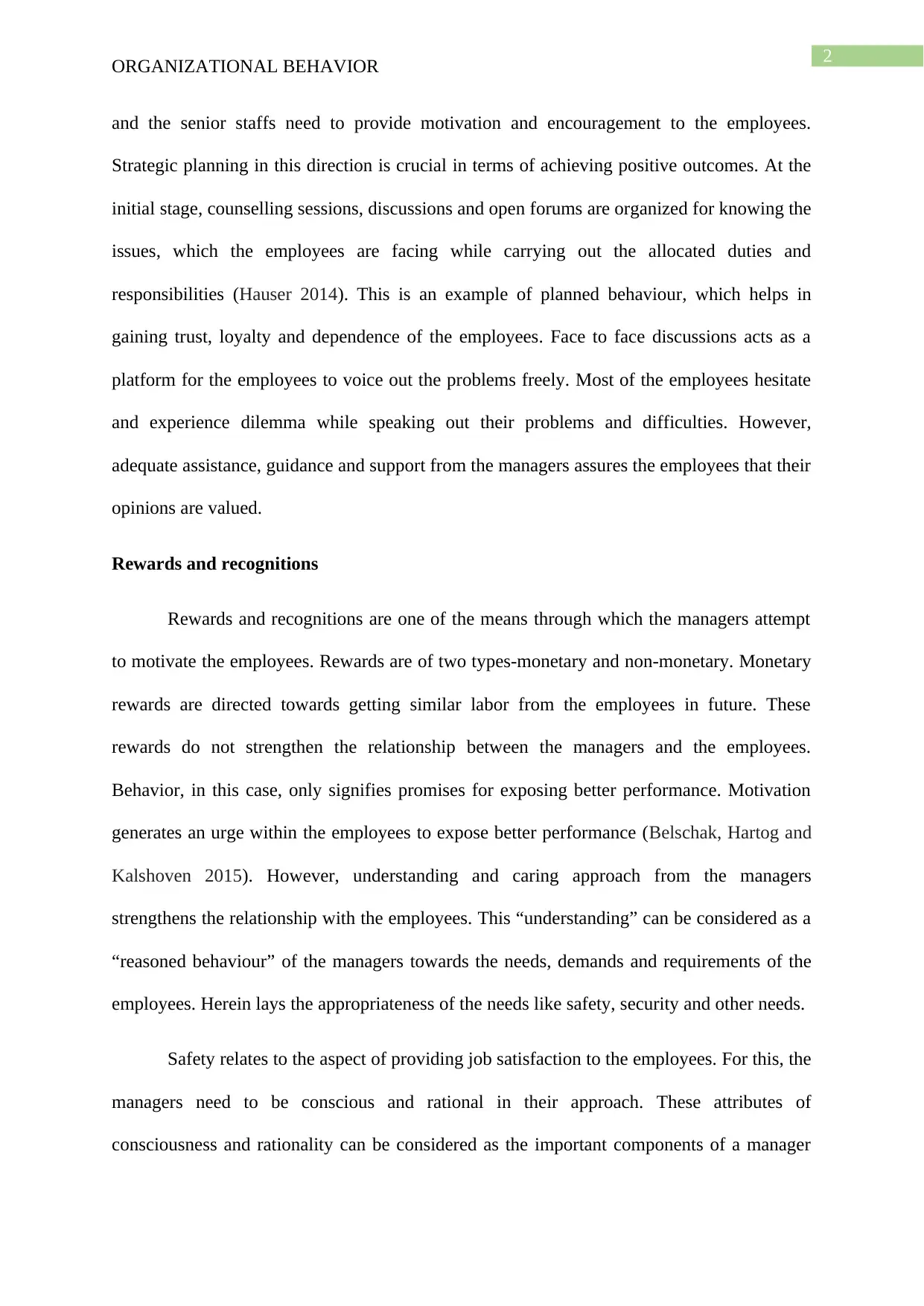
2
ORGANIZATIONAL BEHAVIOR
and the senior staffs need to provide motivation and encouragement to the employees.
Strategic planning in this direction is crucial in terms of achieving positive outcomes. At the
initial stage, counselling sessions, discussions and open forums are organized for knowing the
issues, which the employees are facing while carrying out the allocated duties and
responsibilities (Hauser 2014). This is an example of planned behaviour, which helps in
gaining trust, loyalty and dependence of the employees. Face to face discussions acts as a
platform for the employees to voice out the problems freely. Most of the employees hesitate
and experience dilemma while speaking out their problems and difficulties. However,
adequate assistance, guidance and support from the managers assures the employees that their
opinions are valued.
Rewards and recognitions
Rewards and recognitions are one of the means through which the managers attempt
to motivate the employees. Rewards are of two types-monetary and non-monetary. Monetary
rewards are directed towards getting similar labor from the employees in future. These
rewards do not strengthen the relationship between the managers and the employees.
Behavior, in this case, only signifies promises for exposing better performance. Motivation
generates an urge within the employees to expose better performance (Belschak, Hartog and
Kalshoven 2015). However, understanding and caring approach from the managers
strengthens the relationship with the employees. This “understanding” can be considered as a
“reasoned behaviour” of the managers towards the needs, demands and requirements of the
employees. Herein lays the appropriateness of the needs like safety, security and other needs.
Safety relates to the aspect of providing job satisfaction to the employees. For this, the
managers need to be conscious and rational in their approach. These attributes of
consciousness and rationality can be considered as the important components of a manager
ORGANIZATIONAL BEHAVIOR
and the senior staffs need to provide motivation and encouragement to the employees.
Strategic planning in this direction is crucial in terms of achieving positive outcomes. At the
initial stage, counselling sessions, discussions and open forums are organized for knowing the
issues, which the employees are facing while carrying out the allocated duties and
responsibilities (Hauser 2014). This is an example of planned behaviour, which helps in
gaining trust, loyalty and dependence of the employees. Face to face discussions acts as a
platform for the employees to voice out the problems freely. Most of the employees hesitate
and experience dilemma while speaking out their problems and difficulties. However,
adequate assistance, guidance and support from the managers assures the employees that their
opinions are valued.
Rewards and recognitions
Rewards and recognitions are one of the means through which the managers attempt
to motivate the employees. Rewards are of two types-monetary and non-monetary. Monetary
rewards are directed towards getting similar labor from the employees in future. These
rewards do not strengthen the relationship between the managers and the employees.
Behavior, in this case, only signifies promises for exposing better performance. Motivation
generates an urge within the employees to expose better performance (Belschak, Hartog and
Kalshoven 2015). However, understanding and caring approach from the managers
strengthens the relationship with the employees. This “understanding” can be considered as a
“reasoned behaviour” of the managers towards the needs, demands and requirements of the
employees. Herein lays the appropriateness of the needs like safety, security and other needs.
Safety relates to the aspect of providing job satisfaction to the employees. For this, the
managers need to be conscious and rational in their approach. These attributes of
consciousness and rationality can be considered as the important components of a manager
⊘ This is a preview!⊘
Do you want full access?
Subscribe today to unlock all pages.

Trusted by 1+ million students worldwide
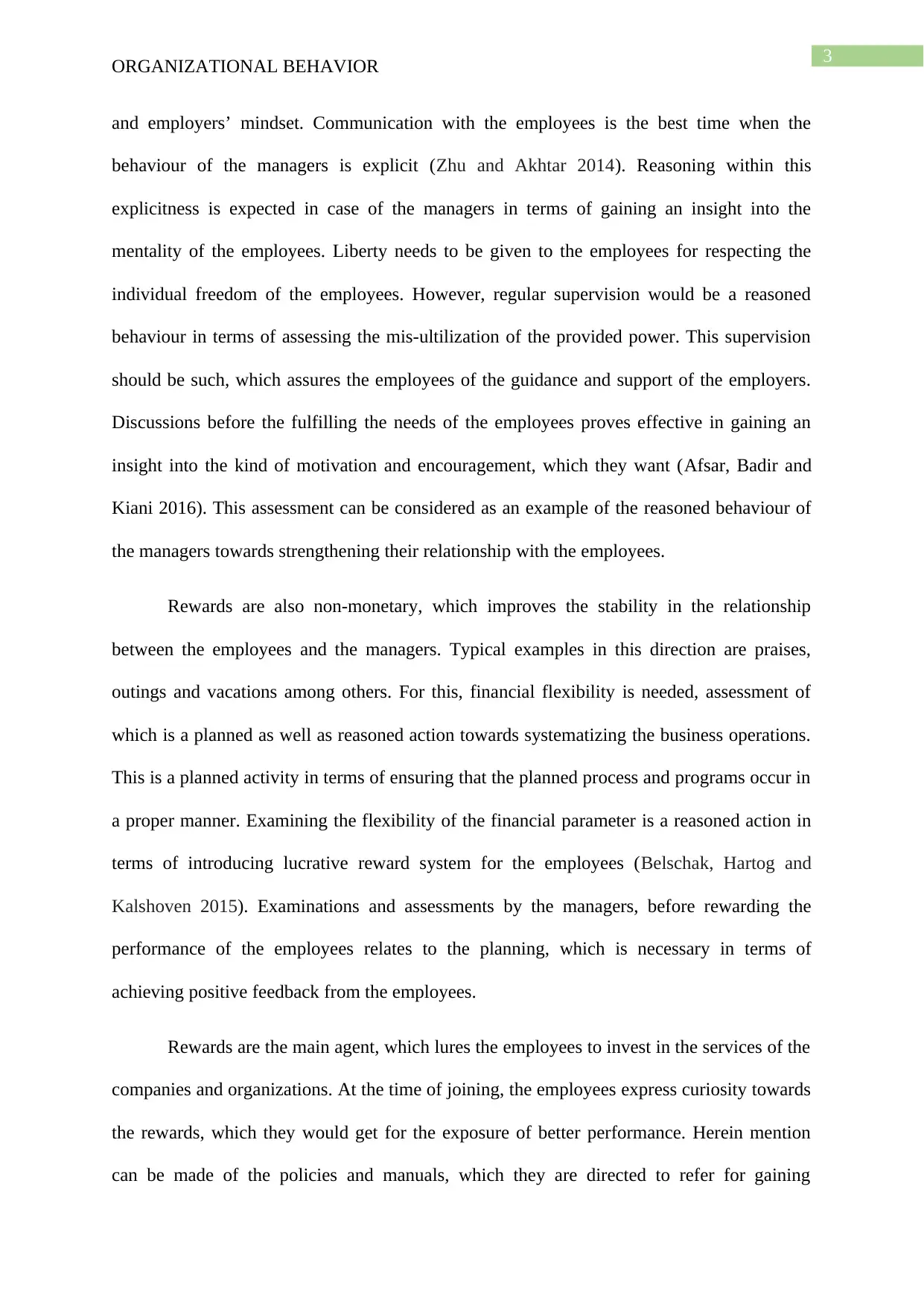
3
ORGANIZATIONAL BEHAVIOR
and employers’ mindset. Communication with the employees is the best time when the
behaviour of the managers is explicit (Zhu and Akhtar 2014). Reasoning within this
explicitness is expected in case of the managers in terms of gaining an insight into the
mentality of the employees. Liberty needs to be given to the employees for respecting the
individual freedom of the employees. However, regular supervision would be a reasoned
behaviour in terms of assessing the mis-ultilization of the provided power. This supervision
should be such, which assures the employees of the guidance and support of the employers.
Discussions before the fulfilling the needs of the employees proves effective in gaining an
insight into the kind of motivation and encouragement, which they want (Afsar, Badir and
Kiani 2016). This assessment can be considered as an example of the reasoned behaviour of
the managers towards strengthening their relationship with the employees.
Rewards are also non-monetary, which improves the stability in the relationship
between the employees and the managers. Typical examples in this direction are praises,
outings and vacations among others. For this, financial flexibility is needed, assessment of
which is a planned as well as reasoned action towards systematizing the business operations.
This is a planned activity in terms of ensuring that the planned process and programs occur in
a proper manner. Examining the flexibility of the financial parameter is a reasoned action in
terms of introducing lucrative reward system for the employees (Belschak, Hartog and
Kalshoven 2015). Examinations and assessments by the managers, before rewarding the
performance of the employees relates to the planning, which is necessary in terms of
achieving positive feedback from the employees.
Rewards are the main agent, which lures the employees to invest in the services of the
companies and organizations. At the time of joining, the employees express curiosity towards
the rewards, which they would get for the exposure of better performance. Herein mention
can be made of the policies and manuals, which they are directed to refer for gaining
ORGANIZATIONAL BEHAVIOR
and employers’ mindset. Communication with the employees is the best time when the
behaviour of the managers is explicit (Zhu and Akhtar 2014). Reasoning within this
explicitness is expected in case of the managers in terms of gaining an insight into the
mentality of the employees. Liberty needs to be given to the employees for respecting the
individual freedom of the employees. However, regular supervision would be a reasoned
behaviour in terms of assessing the mis-ultilization of the provided power. This supervision
should be such, which assures the employees of the guidance and support of the employers.
Discussions before the fulfilling the needs of the employees proves effective in gaining an
insight into the kind of motivation and encouragement, which they want (Afsar, Badir and
Kiani 2016). This assessment can be considered as an example of the reasoned behaviour of
the managers towards strengthening their relationship with the employees.
Rewards are also non-monetary, which improves the stability in the relationship
between the employees and the managers. Typical examples in this direction are praises,
outings and vacations among others. For this, financial flexibility is needed, assessment of
which is a planned as well as reasoned action towards systematizing the business operations.
This is a planned activity in terms of ensuring that the planned process and programs occur in
a proper manner. Examining the flexibility of the financial parameter is a reasoned action in
terms of introducing lucrative reward system for the employees (Belschak, Hartog and
Kalshoven 2015). Examinations and assessments by the managers, before rewarding the
performance of the employees relates to the planning, which is necessary in terms of
achieving positive feedback from the employees.
Rewards are the main agent, which lures the employees to invest in the services of the
companies and organizations. At the time of joining, the employees express curiosity towards
the rewards, which they would get for the exposure of better performance. Herein mention
can be made of the policies and manuals, which they are directed to refer for gaining
Paraphrase This Document
Need a fresh take? Get an instant paraphrase of this document with our AI Paraphraser

4
ORGANIZATIONAL BEHAVIOR
knowledge about the reward policies. This is a planned action, however, if the managers
conduct sessions for explaining the policies to the employees, they would be able to gain an
insight into the grasping power of the employees (Kanfer and Chen 2016).
Training
Motivation can be provided through the means of training. This is through the means
of assuring the employees that they can perform the challenging and enduring tasks. For this,
assessment needs to be done of their capabilities. Herein lays the appropriateness of the post
training tests, which helps the managers to enhance their awareness about the capability of
the employees. This assessment results in the allocation of duties and responsibilities
according to the expertise of the employees. This type of allocation hampers the growth of
the thinking process of the employees (Lazaroiu 2015). This obstacle can be a major issue, if
not considered from an early stage. Herein lays the role of the managers, who need to check
whether the employees are able to perform the allocated tasks and the responsibilities. This
checking would assure the employees that they are getting the proper guidance and support.
Managerial approach
Liberal approach is fruitful for the employees in terms of clarifying their doubts in the
allocated duties and responsibilities. If the managers are liberal in their approach, the
employees feel free towards speaking out the problems, which they are facing while carrying
out the activities. Private counselling sessions prove beneficial in maintaining the stability in
the relationship between the employees and the managers (Hauser 2014). Herein lays the
appropriateness of Date Protection Act (1998), which helps the managers in ensuring the
security of the personal data of the clients and the customers. This security brings Maslow’s
Hierarchy of Needs into the discussion, as security is one of the vital needs for enhancing the
ORGANIZATIONAL BEHAVIOR
knowledge about the reward policies. This is a planned action, however, if the managers
conduct sessions for explaining the policies to the employees, they would be able to gain an
insight into the grasping power of the employees (Kanfer and Chen 2016).
Training
Motivation can be provided through the means of training. This is through the means
of assuring the employees that they can perform the challenging and enduring tasks. For this,
assessment needs to be done of their capabilities. Herein lays the appropriateness of the post
training tests, which helps the managers to enhance their awareness about the capability of
the employees. This assessment results in the allocation of duties and responsibilities
according to the expertise of the employees. This type of allocation hampers the growth of
the thinking process of the employees (Lazaroiu 2015). This obstacle can be a major issue, if
not considered from an early stage. Herein lays the role of the managers, who need to check
whether the employees are able to perform the allocated tasks and the responsibilities. This
checking would assure the employees that they are getting the proper guidance and support.
Managerial approach
Liberal approach is fruitful for the employees in terms of clarifying their doubts in the
allocated duties and responsibilities. If the managers are liberal in their approach, the
employees feel free towards speaking out the problems, which they are facing while carrying
out the activities. Private counselling sessions prove beneficial in maintaining the stability in
the relationship between the employees and the managers (Hauser 2014). Herein lays the
appropriateness of Date Protection Act (1998), which helps the managers in ensuring the
security of the personal data of the clients and the customers. This security brings Maslow’s
Hierarchy of Needs into the discussion, as security is one of the vital needs for enhancing the
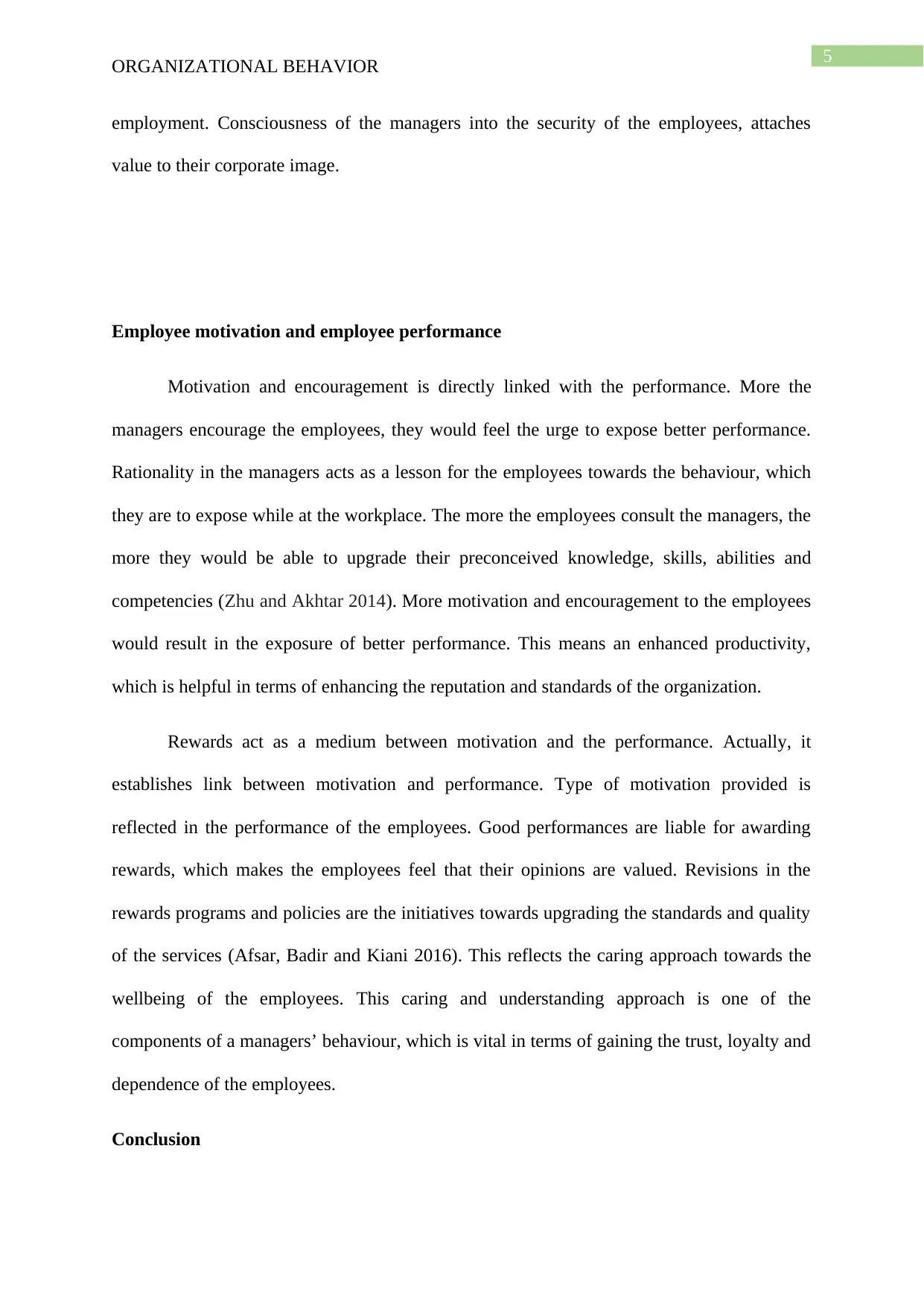
5
ORGANIZATIONAL BEHAVIOR
employment. Consciousness of the managers into the security of the employees, attaches
value to their corporate image.
Employee motivation and employee performance
Motivation and encouragement is directly linked with the performance. More the
managers encourage the employees, they would feel the urge to expose better performance.
Rationality in the managers acts as a lesson for the employees towards the behaviour, which
they are to expose while at the workplace. The more the employees consult the managers, the
more they would be able to upgrade their preconceived knowledge, skills, abilities and
competencies (Zhu and Akhtar 2014). More motivation and encouragement to the employees
would result in the exposure of better performance. This means an enhanced productivity,
which is helpful in terms of enhancing the reputation and standards of the organization.
Rewards act as a medium between motivation and the performance. Actually, it
establishes link between motivation and performance. Type of motivation provided is
reflected in the performance of the employees. Good performances are liable for awarding
rewards, which makes the employees feel that their opinions are valued. Revisions in the
rewards programs and policies are the initiatives towards upgrading the standards and quality
of the services (Afsar, Badir and Kiani 2016). This reflects the caring approach towards the
wellbeing of the employees. This caring and understanding approach is one of the
components of a managers’ behaviour, which is vital in terms of gaining the trust, loyalty and
dependence of the employees.
Conclusion
ORGANIZATIONAL BEHAVIOR
employment. Consciousness of the managers into the security of the employees, attaches
value to their corporate image.
Employee motivation and employee performance
Motivation and encouragement is directly linked with the performance. More the
managers encourage the employees, they would feel the urge to expose better performance.
Rationality in the managers acts as a lesson for the employees towards the behaviour, which
they are to expose while at the workplace. The more the employees consult the managers, the
more they would be able to upgrade their preconceived knowledge, skills, abilities and
competencies (Zhu and Akhtar 2014). More motivation and encouragement to the employees
would result in the exposure of better performance. This means an enhanced productivity,
which is helpful in terms of enhancing the reputation and standards of the organization.
Rewards act as a medium between motivation and the performance. Actually, it
establishes link between motivation and performance. Type of motivation provided is
reflected in the performance of the employees. Good performances are liable for awarding
rewards, which makes the employees feel that their opinions are valued. Revisions in the
rewards programs and policies are the initiatives towards upgrading the standards and quality
of the services (Afsar, Badir and Kiani 2016). This reflects the caring approach towards the
wellbeing of the employees. This caring and understanding approach is one of the
components of a managers’ behaviour, which is vital in terms of gaining the trust, loyalty and
dependence of the employees.
Conclusion
⊘ This is a preview!⊘
Do you want full access?
Subscribe today to unlock all pages.

Trusted by 1+ million students worldwide
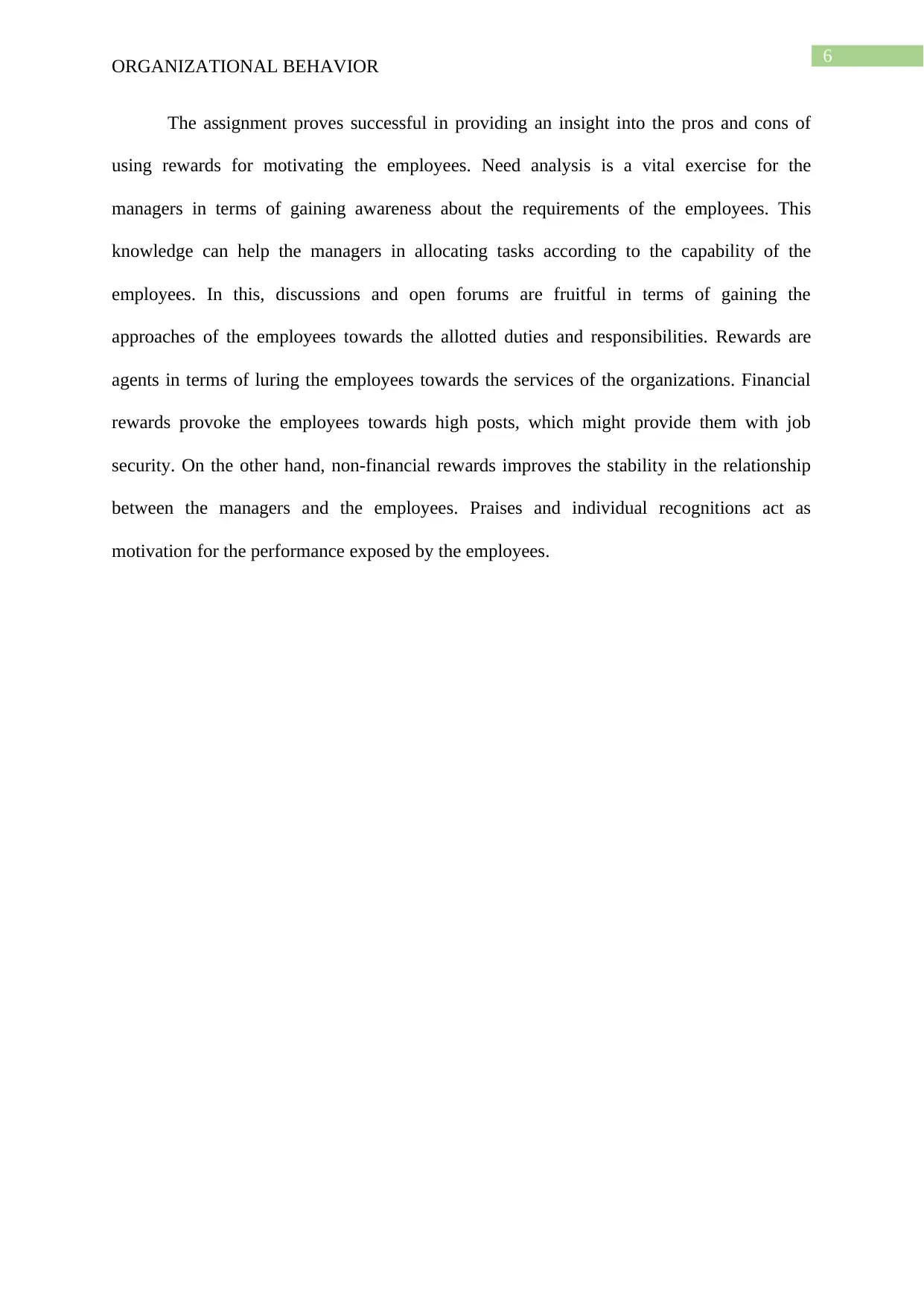
6
ORGANIZATIONAL BEHAVIOR
The assignment proves successful in providing an insight into the pros and cons of
using rewards for motivating the employees. Need analysis is a vital exercise for the
managers in terms of gaining awareness about the requirements of the employees. This
knowledge can help the managers in allocating tasks according to the capability of the
employees. In this, discussions and open forums are fruitful in terms of gaining the
approaches of the employees towards the allotted duties and responsibilities. Rewards are
agents in terms of luring the employees towards the services of the organizations. Financial
rewards provoke the employees towards high posts, which might provide them with job
security. On the other hand, non-financial rewards improves the stability in the relationship
between the managers and the employees. Praises and individual recognitions act as
motivation for the performance exposed by the employees.
ORGANIZATIONAL BEHAVIOR
The assignment proves successful in providing an insight into the pros and cons of
using rewards for motivating the employees. Need analysis is a vital exercise for the
managers in terms of gaining awareness about the requirements of the employees. This
knowledge can help the managers in allocating tasks according to the capability of the
employees. In this, discussions and open forums are fruitful in terms of gaining the
approaches of the employees towards the allotted duties and responsibilities. Rewards are
agents in terms of luring the employees towards the services of the organizations. Financial
rewards provoke the employees towards high posts, which might provide them with job
security. On the other hand, non-financial rewards improves the stability in the relationship
between the managers and the employees. Praises and individual recognitions act as
motivation for the performance exposed by the employees.
Paraphrase This Document
Need a fresh take? Get an instant paraphrase of this document with our AI Paraphraser
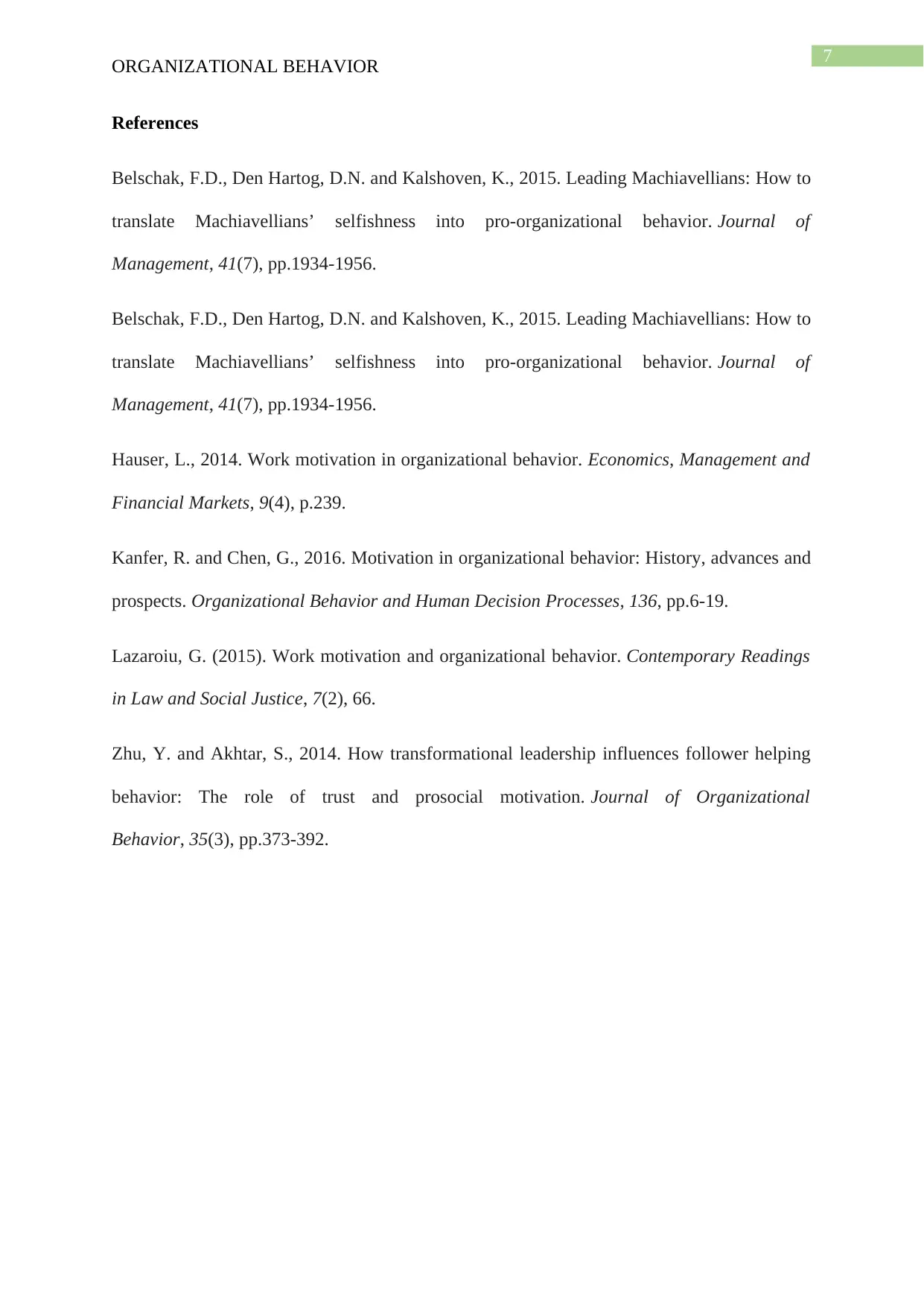
7
ORGANIZATIONAL BEHAVIOR
References
Belschak, F.D., Den Hartog, D.N. and Kalshoven, K., 2015. Leading Machiavellians: How to
translate Machiavellians’ selfishness into pro-organizational behavior. Journal of
Management, 41(7), pp.1934-1956.
Belschak, F.D., Den Hartog, D.N. and Kalshoven, K., 2015. Leading Machiavellians: How to
translate Machiavellians’ selfishness into pro-organizational behavior. Journal of
Management, 41(7), pp.1934-1956.
Hauser, L., 2014. Work motivation in organizational behavior. Economics, Management and
Financial Markets, 9(4), p.239.
Kanfer, R. and Chen, G., 2016. Motivation in organizational behavior: History, advances and
prospects. Organizational Behavior and Human Decision Processes, 136, pp.6-19.
Lazaroiu, G. (2015). Work motivation and organizational behavior. Contemporary Readings
in Law and Social Justice, 7(2), 66.
Zhu, Y. and Akhtar, S., 2014. How transformational leadership influences follower helping
behavior: The role of trust and prosocial motivation. Journal of Organizational
Behavior, 35(3), pp.373-392.
ORGANIZATIONAL BEHAVIOR
References
Belschak, F.D., Den Hartog, D.N. and Kalshoven, K., 2015. Leading Machiavellians: How to
translate Machiavellians’ selfishness into pro-organizational behavior. Journal of
Management, 41(7), pp.1934-1956.
Belschak, F.D., Den Hartog, D.N. and Kalshoven, K., 2015. Leading Machiavellians: How to
translate Machiavellians’ selfishness into pro-organizational behavior. Journal of
Management, 41(7), pp.1934-1956.
Hauser, L., 2014. Work motivation in organizational behavior. Economics, Management and
Financial Markets, 9(4), p.239.
Kanfer, R. and Chen, G., 2016. Motivation in organizational behavior: History, advances and
prospects. Organizational Behavior and Human Decision Processes, 136, pp.6-19.
Lazaroiu, G. (2015). Work motivation and organizational behavior. Contemporary Readings
in Law and Social Justice, 7(2), 66.
Zhu, Y. and Akhtar, S., 2014. How transformational leadership influences follower helping
behavior: The role of trust and prosocial motivation. Journal of Organizational
Behavior, 35(3), pp.373-392.
1 out of 8
Related Documents
Your All-in-One AI-Powered Toolkit for Academic Success.
+13062052269
info@desklib.com
Available 24*7 on WhatsApp / Email
![[object Object]](/_next/static/media/star-bottom.7253800d.svg)
Unlock your academic potential
Copyright © 2020–2025 A2Z Services. All Rights Reserved. Developed and managed by ZUCOL.





